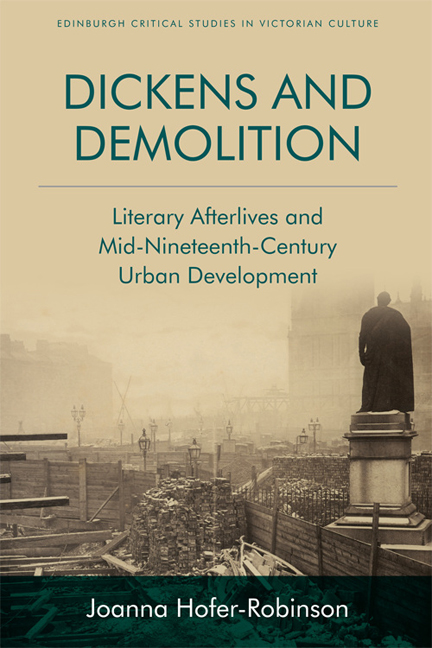Book contents
- Frontmatter
- Contents
- List of Illustration
- Acknowledgements
- Series Editor’s Preface
- Abbreviations and a Note on Editions
- Dedication
- Introduction
- 1 Charles Dickens and Metropolitan Improvements
- 2 Sets and the City: Staging London and Oliver Twist
- 3 Dickensian Afterlives and the Demolition of Field Lane
- 4 Paperwork and Philanthropy: Dickens’s Involvement in Metropolitan Improvement
- 5 From Sanit ary Reform to Cultural Memory: The Case of Jacob’s Island
- Coda
- Archival Sources and a Note on Method
- Select Bibliography
- Index
- Plate Section
1 - Charles Dickens and Metropolitan Improvements
Published online by Cambridge University Press: 29 April 2021
- Frontmatter
- Contents
- List of Illustration
- Acknowledgements
- Series Editor’s Preface
- Abbreviations and a Note on Editions
- Dedication
- Introduction
- 1 Charles Dickens and Metropolitan Improvements
- 2 Sets and the City: Staging London and Oliver Twist
- 3 Dickensian Afterlives and the Demolition of Field Lane
- 4 Paperwork and Philanthropy: Dickens’s Involvement in Metropolitan Improvement
- 5 From Sanit ary Reform to Cultural Memory: The Case of Jacob’s Island
- Coda
- Archival Sources and a Note on Method
- Select Bibliography
- Index
- Plate Section
Summary
London was a very different city at the end of the nineteenth century from what it had been at the start. Suburban expansion pushed the city's perimeter outward in every direction. Dilapidated inner-city areas were cleared to make way for new housing, commercial buildings and infrastructure. Monumental architecture was built to reflect, and help to construct, London's identity as the capital of an empire. Even the colours of the city changed. Alongside the century's eclectic use of architectural styles, building materials were updated and Londoners saw street scenes alter ‘from brown brick to brawn and red, then to red; from Portland stone to granite or Mansfield or to red or buff terracotta’. The streets were also much busier, as the metropolitan population was swollen by mass inward migration from rural England and overseas, as well as natural growth. In the term commonly used by nineteenth-century commentators and developers, London was improving. However, progress was slow. Large-scale demolitions, supposed to make room for new construction, in fact created sites that resembled wastelands in the heart of the city. Owing to delays, obstructions from local government, or the mothballing of partially complete projects, these liminal spaces occupied central districts for long periods. For example, the whole of the Farringdon Street area was cleared in the mid-1830s and remained undeveloped for more than thirty years, becoming known as ‘Farringdon Waste’. Connoting both a barren, alienating space and the mismanagement of resources, the name preserves derisive popular responses to metropolitan improvements that coexisted with the positive claims of their backers. Still, calls for better living conditions and infrastructural development in the mid-nineteenth century resulted in more demolition. Figure 1.1 gives a snapshot of further destruction near to Farringdon in the 1860s. Henry Flather's photograph depicts railway navvies building the underground Metropolitan District railway line, using the ‘cut-and-cover’ method, which dug up roads so that tracks could be laid below street level. It was taken from the west side of Blackfriars Bridge, looking north-east towards St Paul's Cathedral, which can be seen in the background. The photograph thus gives a perspective on how, in the mid-nineteenth century, monumental architecture, and the technological advances represented by railway construction, sat uneasily beside vast and visible disordered spaces, and by remaining slums, which were often made more noticeable by the destruction of other buildings that had previously masked them from view.
- Type
- Chapter
- Information
- Dickens and DemolitionLiterary Afterlives and Mid-Nineteenth Century Urban Development, pp. 19 - 50Publisher: Edinburgh University PressPrint publication year: 2018



